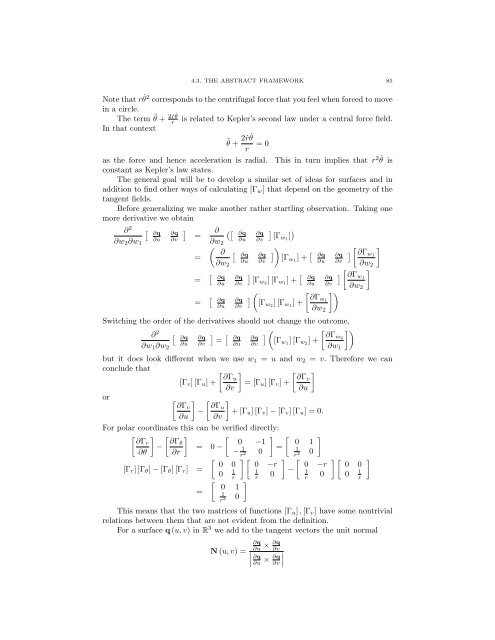Lecture Notes for 120 - UCLA Department of Mathematics
Lecture Notes for 120 - UCLA Department of Mathematics
Lecture Notes for 120 - UCLA Department of Mathematics
You also want an ePaper? Increase the reach of your titles
YUMPU automatically turns print PDFs into web optimized ePapers that Google loves.
4.3. THE ABSTRACT FRAMEWORK 85<br />
Note that r ˙✓ 2 corresponds to the centrifugal <strong>for</strong>ce that you feel when <strong>for</strong>ced to move<br />
in a circle.<br />
The term ¨✓ 2ṙ ˙✓<br />
+<br />
r<br />
is related to Kepler’s second law under a central <strong>for</strong>ce field.<br />
In that context<br />
2ṙ ˙✓<br />
¨✓ + =0<br />
r<br />
as the <strong>for</strong>ce and hence acceleration is radial. This in turn implies that r 2 ˙✓ is<br />
constant as Kepler’s law states.<br />
The general goal will be to develop a similar set <strong>of</strong> ideas <strong>for</strong> surfaces and in<br />
addition to find other ways <strong>of</strong> calculating [ w] that depend on the geometry <strong>of</strong> the<br />
tangent fields.<br />
Be<strong>for</strong>e generalizing we make another rather startling observation. Taking one<br />
more derivative we obtain<br />
@ 2 ⇥ @q<br />
⇤<br />
@q @ ⇥<br />
=<br />
@q<br />
⇤<br />
@q<br />
@w 2 @w<br />
@u @v<br />
1 @w<br />
@u @v [ w 1<br />
]<br />
✓ 2<br />
@ ⇥<br />
=<br />
@q<br />
⇤ ◆ @q<br />
[<br />
@w<br />
@u @v w 1<br />
]+ ⇥ ⇤ apple @q @q @ w1<br />
@u @v<br />
2 @w 2<br />
= ⇥ @q<br />
@u<br />
= ⇥ @q<br />
@u<br />
@q<br />
@v<br />
@q<br />
@v<br />
⇤<br />
[ w 2<br />
][ w 1<br />
]+ ⇥ @q<br />
@u<br />
⇤ ✓ [ w 2<br />
][ w 1<br />
]+apple @ w1<br />
@w 2<br />
@q<br />
@v<br />
⇤ apple @ w1<br />
@w 2<br />
◆<br />
Switching the order <strong>of</strong> the derivatives should not change the outcome,<br />
@ 2 ⇥ @q<br />
⇤ ⇥<br />
@q<br />
@w 1 @w<br />
@u @v = @q<br />
⇤ ✓ ◆<br />
@q<br />
@ w2<br />
[<br />
@u @v w 1<br />
][ w 2<br />
]+apple<br />
2 @w 1<br />
but it does look different when we use w 1 = u and w 2 = v. There<strong>for</strong>e we can<br />
conclude that<br />
apple apple @ u<br />
@ v<br />
[ v][ u]+ =[ u][ v]+<br />
@v<br />
@u<br />
or<br />
apple @ v<br />
@u<br />
apple @ u<br />
@v<br />
+[ u][ v] [ v][ u] =0.<br />
For polar coordinates this can be verified directly:<br />
apple apple apple<br />
apple @ r @ ✓<br />
0 1 0 1<br />
= 0 1 = 1<br />
@✓ @r<br />
r<br />
0 2 r<br />
0<br />
apple apple apple 2<br />
0 0 0 r 0<br />
[ r][ ✓] [ ✓][ r] =<br />
1 1<br />
0<br />
r r<br />
0<br />
apple 0 1<br />
=<br />
1<br />
r 2 0<br />
r<br />
1<br />
r<br />
0<br />
apple 0 0<br />
0<br />
1<br />
r<br />
This means that the two matrices <strong>of</strong> functions [ u] , [ v] have some nontrivial<br />
relations between them that are not evident from the definition.<br />
For a surface q (u, v) in R 3 we add to the tangent vectors the unit normal<br />
N (u, v) =<br />
@q<br />
@u ⇥ @q<br />
@v<br />
@q<br />
@u ⇥ @q<br />
@v
















